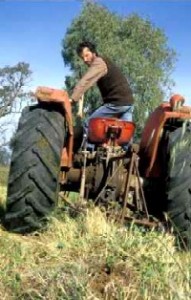First published in Habitat Australia, February 1988.
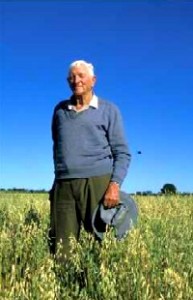
Grandfather Austie L’Estrange in an oat crop on land he cleared with an axe as a young man near Condobolin, NSW. Photo by Merrill Findlay, 1987.
Country town. Interstate bus. They’re all there to meet me. It’s spring time and the roadsides are splashed with purple Patterson’s Curse and the exotic yellow daisies we call pee-the-beds. The crops are young and green, just starting to head, and the trees silhouetted against the setting sun as we drive home — well, I’m afraid there aren’t many of them left these days, except along the road reserves. European agricultural practices haven’t been good for trees in this country. Nor for the land itself.
The process of deforestation and soil degradation began last century when whitefellas, ordinary young men and women, crossed the Blue Mountains from Sydney to take up this so-called unoccupied land, this ‘terra nullius’. Amongst them were several Anglo-Celtic couples to whom I owe my roots in rural Australia: I am one of hundreds of great-grandchildren and great-greats who are testimony to the pioneering and other activities of these settlers west of the Great Dividing Range.
My extended family is proud of our third, fourth and fifth generation status, but for ‘old’ settler families in inland Australia there are many ghosts. Many things better left unsaid. Few of my relatives ever talk about the traditional landowners, the people of the Wiradjuri nation, or what happened to them after our forebears arrived, for example. And it’s hard to talk about how the land has been and is still being degraded.
It’s common knowledge that more and more country is becoming unproductive from salinity and erosion caused by clearing and over-stocking, but where do you allocate blame? There are so many pressures on landholders, and many of their mistakes have been made through ignorance rather than greed. It is very expensive to solve the problems from the past, and very hard to change current agricultural practices to break the century-old pattern of land degradation. It costs a lot to plant and maintain trees on farms, for example. And it’s hard work.
But we don’t mention much of this on the way home. Instead, it’s all family news and gossip. Which cousin has had the latest baby, who is about to, how the sheep and cattle are selling, what price the wool clip might bring, how much rain we need, what we’ve each been doing since our last reunion … but trees are on the agenda. Because we have a kind of family plan: somehow we want to pass our farm on to future generations in a better condition than when we received it. My generation cannot plead ignorance.
I speak as if our family has some kind of homogeneous world (or farm) view and unified sense of purpose. Nothing could be further from the truth! The parents, very strong individuals themselves, threw a trio of nonconformists who hardly see eye-to-eye on anything! One of the few things we all agree on, though, is that we need more trees on the farm. But it’s very optimistic to believe we’ll ever actually reach accord on where they should go, or when, why or how, despite our long term objective.
Discussions and lobbying begin at dinner after the long trip from town. Mark, brother number one, has some river red gums he wants to put near the house dam. Father has some tagasaste he wants to try as a fodder crop. I want to plant a patch of mixed locally endemic species up near the shearing shed to recreate something like natural bushland. Brett, brother number two, hasn’t arrived back from agricultural college yet, but he’s sure to want something different. And mother, well, she just wants peace and harmony! We drop the subject until all parties are present, and I make plans for my regular pilgrimage to visit the grandfather in Condobolin, a further thirty miles west.
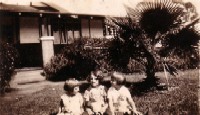
Two of Austie and Agnes’s three daughters, Dorothy and Louis, with cousin Colleen in the early 1930s, in the garden of the house Austie built. All the timber for this house was cut and milled to size on the family property. One of the old couple’s grandsons and his family are now living in this house and are farming the land Austie cleared.
The old fellow, the only remaining grandparent, is 92 and is feeling the weight of his years. He is proud to have spent all his life in the district his family settled in the 1870s, and finds it hard to understand why his more wayward grandchildren should choose to live anywhere else. My mother and I decide to take him for a drive out to his old home, the farm another of his daughters, my aunt, and her family now live on.
“It was all scrub in those days,” Grandfather says as we drive him along the dirt track between the crops. “We pulled out most of the trees in this paddock with bullocks. Sixteen to a team. Some of them were too hard to pull out, so we’d look for a tree with a good fork in it, cut it down with an axe, then hook it up to the bullock team and use it as a lever to push the other trees out. We carried axes with us to cut the limbs off and we’d pile them against the trunks to be burned. The stumps had to be burnt out too. Root carting was another job. We’d cut them four inches below the surface and throw them on the back of a wagon. It’d be about twelve months before you could plough. This is going back fifty or sixty years or so,” he says, as we stop to open a gate.
“More than that,” my mother interjects quickly. “I’m sixty, Bost! This paddock was always cleared in my time. I remember the back paddock being cleared when I was a small child though, fifty or so years ago,” she adds. “Remember the Phillips worked up there?”
“We used to ride our bikes up with the billy of milk for them,” my aunt says.
“That’s right! They had two or three small children and they lived in a tent in the back paddock. They were ring-barking. But that was the only paddock I can remember with much timber on it from when I was a child,” Mother says. She looks at me. “Don’t you remember Benny Pack? He was doing a bit of ring-barking for us when you were small.”
I remember him. A man born on the wrong side of the track trying to make a living any way he could. And my parents, younger then, just wanting to improve their land to carry more stock. In this car, three generations of memories spanning nearly a century of tree felling. The story of the deforestation of this country is the story of my family. It’s part of me.

Austie and daughters Louis (left) and Dorothy, on the farm they grew up on. Photo by Merrill Findlay, 1987.
We stop for a gate. My aunt attempts to open it and it collapses. “Every farm has one!” says my mum. We giggle and drive into lighter kurrajong country.
“I bet you were grateful for these trees during droughts,” I comment, as we gaze across a paddock dotted still with these elegantly shaped trees that have been lopped ever since my great-grandparents’ time to keep sheep and cattle alive during the dry spells and to protect them during extreme weather.
‘We were, Merski,” my aunt says. “There wasn’t anything else in drought time. Just bare ground.”
The old fellow changes the subject. He doesn’t want to dwell on the hard times. “Those dams had to be put in, and the fences, the gates swung …” he says.
“They’re white cypress pine, the fence posts, aren’t they? And they seem new.”
“Yes, there’s a lot of white cypress out in the back paddock still,” my aunt says. “Actually, I helped sight this end of the fence and it’s crooked! I’ve never lived it down!” We women laugh uproariously. Grandfather is not amused. It wouldn’t have happened in his day!
“As a matter of fact, the timber for the house was cut from the back of this place. Dad used to tell us how it was carried out by Jack MacDonald’s father’s horse and wagon, because his was the biggest one in the district.”
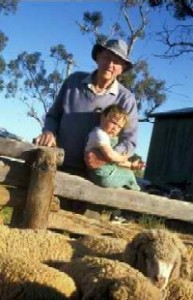
- Austie with his chocolate-cake-smeared great-granddaughter, Joanne, in the sheep yards made from cyprus pine from ‘down the back paddock’. [Twenty years on, Joanne has graduated as a medical doctor and is practicing in country NSW.] Photo by Merrill Findlay, 1987.
We’re heading towards the shearing shed now where my uncle and a couple of cousins are shearing ewes. The air is filled with the bleating of young lambs. As we pull up we’re greeted by a tribe of the old man’s great-grandchildren, all about knee-high and smeared with chocolate cake, a sign that smoko’s on. A cuppa amongst the wool bales, then it’s time to get the old fellow back to town.
In Condobolin I call in at the Government Offices for a yarn with Conservation Farming Officer, Alan McGufficke, and District Forester, Andy Heatly. There’s a map on the wall marking the area these two people administer, and it covers half of New South Wales! The western half. “Where have landholders gone wrong?” I ask. A bit provocative perhaps, but these two men should know.
“Well, over-clearing I think was the main problem,” Allan says, to confirm my own beliefs. ” And then there was poor rotation. The land has probably been over utilised. We tended to bash the hell out of the country, because our farming methods in the past haven’t been good. And possibly overstocking. I’m talking about the Condobolin district specifically, because this is marginal country. Sixteen inches a year. And there has been a lot of damage done in the past.”
“Was this all ignorance?” I ask. Like, there’s a long tradition of ring-barking so grass would grow. The old timers thought they were doing the right thing, didn’t they? They didn’t know it would ultimately lead to problems like widespread wind and water erosion and salinity.”
“You can’t just accuse people of clearing trees and the end result is such and such,” the forester replies. “It’s a combination of factors. The stocking, the cropping, what they’ve done with the country …”
“I s’pose they used to get a bit enthusiastic!” Alan says. “If removing trees was the major way you could increase your production, then you’d probably go for it! But we really didn’t know very much about trees in the past. We know precious little at the moment, as far as agricultural production goes!”
“I think historically it was the European method of doing things,” the district officer continues. “The idea that you just flatten everything and away you go. You just can’t do that!” he says. “I’m talking about the bad old days when people cleared everything. But things have changed. Possibly not as much as they could do, but I have a lot of enquiries coming into the office about what trees to establish and so on. People are becoming aware that their properties are under-stocked with trees and they want to do something about it.”
I leave the office feeling more optimistic. It’s dark by the time we get back to our own plot of ground. We chat and go to bed.

Sandy planting a young eucalypt, one of thousands required to replace those lost in over a century of land clearance. Photo by Merrill Findlay 1987.
Next morning I’m woken early by a widowed peacock screeching from a fence post, a pubescent rooster learning how to crow, and a grey Arabian stallion kicking up his heels. (The peace and quiet of country living is an illusion that only city people suffer from!) At breakfast no one mentions trees. There seem to be more important issues to consider. Like the bulls. Apparently yesterday, while mother and I were in Condo, Mark had rounded up the heifers and locked them in the cattle yards overnight. This was too much for the two bulls who have their own paddock some distance away. Like a couple of randy delinquents they broke through their gate in the night and were now chatting up the ‘schoolgirls’, as Mark’s friend Pol and I call the heifers. We all try to ignore the situation until Mark arrives from his own place a few miles away to deal with it. Somehow the morning just seems to slip away.
“If you want to get those trees planted …” Mother keeps warning. Yes Mum.
Dad’s digging in the vegetable garden listening to Brett rave about some book he is reading, in which the author speculates about how the cosmos has eleven dimensions, instead of the four or five we generally take for granted. Mark’s taking the schoolgirls back to their paddock. Pol is in the kitchen marinating some ducks in brandy, or something. Everyone is busy. “You’re just going to have to organise those trees yourself,” says mother.
I bring the subject up over the traditional cold meat and salad lunch (all home grown). With a little gentle persuasion we reach consensus on a few of the basics. Mark already has the tube stock from the Forestry Commission nursery in Forbes, so it looks like we’ll be planting his red gums, although we might throw in a few of father’s tagasaste as well, as a field trial. Mark also wants to try drip irrigation this time, because he’s sick of having to cart water to thirsty young trees in the droughts, so we’ll have to take that into consideration. Brett and Sandy, our resident ‘authorities’ because of their association with Greening Australia and their tertiary training in this area, reckon weed control and mulching are pretty important if you want the trees to survive, and they recommend tree mats. My view is that, instead of using fancy things like commercial mats, we should improvise with what’s available on the farm, so I suggest old superphosphate bags and newspaper instead. The idea seems okay except that the plastic super bags and paper break down quickly when exposed to moisture and ultraviolet light. Father offers some old hay, if someone else carts it, to solve the UV problem with the super bags. And the rocks left over from when the Council fixed our access road might be good to weigh the bags, paper and hay down to stop them blowing away, although mother says she has always wanted them for a rockery!
Collecting the rocks seems like the hardest job, so somehow Pol and I get nominated for it! We’re graciously offered the use of the old ute for the afternoon. I also get to collect the super bags, newspaper and hay. Brett is unanimously allocated the job of ripping the site. The ripping aerates the soil and makes it considerably easier to dig the holes. In a text book tree planting operation we would be planting in autumn and the ripping would have been done at least six months before, so we suggest that while he has the tractor going he rip a couple of the areas we’d like to plant next year, including my spot up near the shearing shed, and another fenced off area near the hay shed. A bit of forward planning for next time. By the end of the day I’m exhausted and, after a roast lamb dinner, go straight to bed.
At daylight the same ritual as yesterday morning: peacock, rooster, stallion. Although the bulls stay put now that the schoolgirls have been moved to greener pastures. I’m determined that today we are going to get those red gums in!
After breakfast we inspect the site again. It’s permanently fenced off from stock and so, at this time of the year, is knee high in Patterson’s Curse and barley grass. By the time Brett has finished the tractor work this will be flattened and easier for us to work on. (The pin-like barley grass seeds get into your socks and boots and up your trouser legs, which is exceptionally uncomfortable.) The permanent fencing is important though, to prevent stock damage, both at this early stage and in the future, and to promote self-propagation. The site also has permanent water with sufficient pressure for Mark’s drip irrigation.
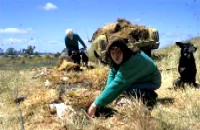
Sandy (foreground), Dorothy and Eddie the Sheep Dog at work greening the family farm. Photo by Merrill Findlay, 1987.
It’s such a visionary thing, planting trees. These fragile little stems, now bearing just a few greeny-red leaves, will one day provide shelter and shade and fire wood, as well as hollows for birds and possums to nest in. They’ll even reduce the evaporation of the water in the dam and from the surrounding pastures, by slowing down the wind speed. But not today. Probably not even this century. And they will only replace a very small fraction of the trees that have been torn from this property by past owners. These are the things Brett, Sandy and I think about as we carefully place each tiny tree in the ground, soak it, and add the mulch. Someone’s children and grandchildren will reap the benefits of our work today, but what kind of world will they inhabit? Will they ever see birds nesting in the hollows of what are now fragile seedlings?
The dinner bell rings. Our musing ends. The only job left now is laying the black polythene pipe and inserting the fittings for the drip irrigation. Mark will do that tomorrow. This evening we have Pol’s marinated ducks to look forward to.
It’s nice to sit down to a fine home-grown meal after a satisfying day’s work with these people. We know one another well, so carefully avoid the subjects we’ll never agree on (which are many.) But trees are safe. We all acknowledge the economic, environmental and aesthetic advantages of planting them now to replace those lost in past generations, and those that have died more recently. Together, at this kitchen table, we discuss double fencing, windbreaks, tree corridors the length and breadth of the place, growing our own seedlings, promoting natural regeneration, perhaps a little agro-forestry … These ideas will take ten, twenty years to develop and implement, maybe a life time. Maybe two lifetimes. Plus a lot of money, and a lot of work. Tree planting is still both very labour intensive and very expensive. But one day the view from the house verandahs might be very different …
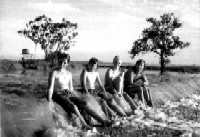
Two lone eucalypts, all that remained of the original riparian vegetation by 1971 when this family photo was taken. The view is now very different thanks to the tree-planting efforts of my generation, but much more remains to be done to restore the riparian zone and revegetate the rest of the farm. (The author, still a teenager at the time, is third from the left in the swimming cap!)
We’re lucky, our family. We are not wealthy — few families are in the bush these days — but unlike many rural people in the world our basic needs are more than adequately met, and so we have the time for longer term planning and for exploring new possibilities. These are luxuries not everyone enjoys, even in Australia.
But what if we were in the positions of our great-grandparents? A few thousand acres of ‘virgin’ bush in a strange and alien land. An extra mouth to feed each year or so. (My grandfather was one of ten children, my grandmother one of twelve.) Few neighbours, or community services. And little agricultural knowledge or experience relevant to local conditions to draw on. What would we be doing and thinking then? Wouldn’t we, in all innocence, be making similar mistakes to those our forebears made?
And how might my descendants (if I have children), or my brothers’ descendants view what we are doing today? Will they understand that the trees we planted were for them too? That they, more than us, will reap from what we have sown?
_____________________
[This story was first published in Habitat magazine in 1988. The web content was revised in March 2004, 5 January 2005, 28 Jan. 2006, and 30 May 2015. A paid advertisement was inserted on 15 May 2010 and deleted a year or two later. The content was uploaded to this new site on 5 December 2010.]
Permalink: https://merrillfindlay.com/ccd-projects/river-stories/greening-the-family-farm
© This material is subject to copyright and any unauthorised use, copying or mirroring is prohibited.

